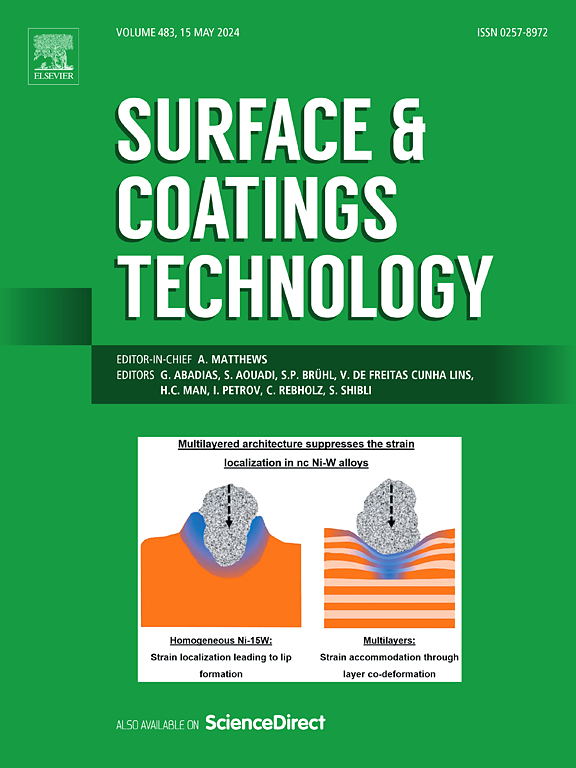Insight into plasma polymerization with a significant contribution of etching to the deposition process
IF 5.3
2区 材料科学
Q1 MATERIALS SCIENCE, COATINGS & FILMS
引用次数: 0
Abstract
Plasma polymer deposition processes are well-studied and optimized on flat substrates. Understanding the role of substrate geometry is crucial for optimizing deposition on non-planar substrates. We investigated the altered transport of film-forming species into two 3D geometries, cavities with a slit opening and a cavity with an undercut, to assess the contribution of ions to the deposition and etching and to estimate the sticking coefficient of depositing species for the CO2/C2H4/Ar gas mixture. Profilometry and ellipsometry were employed to obtain film thicknesses. It revealed a significant extension of the deposition inside the cavities attributed to film-forming species with a low sticking coefficient. These depositing species contain less oxygen because a spatially resolved ATR-FTIR analysis revealed an increasing proportion of hydrocarbons further inside the cavity. Inside the cavities with a slit, the film thickness exceeded its value on the flat Si surface outside. This difference indicated that ions responsible for etching collide during their flight toward the growing film inside the slit. However, it also suggests that some ionic species contribute to the deposition because directional species become more prominent under the slit than outside due to the geometrical shielding of thermalized species represented by the structure’s angular aperture. Monte Carlo simulations inside the cavity with different slits confirmed that diffusion alone did not explain the experimentally obtained profiles, as the model considering thermalized deposition and etching particles is not able to reproduce the narrow film thickness profiles obtained in the cavities with a slit. The model with directional particles demonstrated significantly better agreement.
求助全文
约1分钟内获得全文
求助全文
来源期刊

Surface & Coatings Technology
工程技术-材料科学:膜
CiteScore
10.00
自引率
11.10%
发文量
921
审稿时长
19 days
期刊介绍:
Surface and Coatings Technology is an international archival journal publishing scientific papers on significant developments in surface and interface engineering to modify and improve the surface properties of materials for protection in demanding contact conditions or aggressive environments, or for enhanced functional performance. Contributions range from original scientific articles concerned with fundamental and applied aspects of research or direct applications of metallic, inorganic, organic and composite coatings, to invited reviews of current technology in specific areas. Papers submitted to this journal are expected to be in line with the following aspects in processes, and properties/performance:
A. Processes: Physical and chemical vapour deposition techniques, thermal and plasma spraying, surface modification by directed energy techniques such as ion, electron and laser beams, thermo-chemical treatment, wet chemical and electrochemical processes such as plating, sol-gel coating, anodization, plasma electrolytic oxidation, etc., but excluding painting.
B. Properties/performance: friction performance, wear resistance (e.g., abrasion, erosion, fretting, etc), corrosion and oxidation resistance, thermal protection, diffusion resistance, hydrophilicity/hydrophobicity, and properties relevant to smart materials behaviour and enhanced multifunctional performance for environmental, energy and medical applications, but excluding device aspects.
 求助内容:
求助内容: 应助结果提醒方式:
应助结果提醒方式:


